The sixth generation of thin and light mobile workstations
Five generations of Precision thin and light mobile workstations precede the 5550. The first was the Precision M3800 followed by the 5510 to the 5540. The 5510 through 5540 models adapted new technology for each revision, but the industrial design remained constant. The Precision 5550 is a new design which is significantly more compact yet delivers performance and good looks.
The table shows the dimensions and weights for each generation.
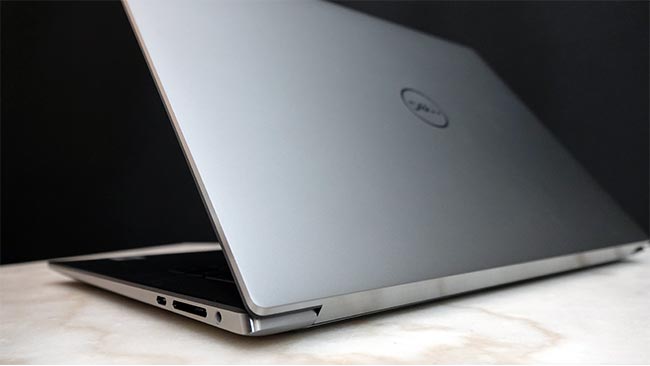
Fast, compact, and stylish - the Precision 5550 is a completely new design for the 5500 series.
|
Precision Model |
Width |
Depth |
Height - Front |
Height – Rear |
Surface Area |
Weight |
|
5550 |
344.4 mm |
230.3 mm |
7.7 mm |
11.6 mm |
79.315 mm2 |
1.84 kg |
|
5540 |
357.23 mm |
235.47 mm |
11.48 mm |
16.82 mm |
84.117 mm2 |
1.78 kg |
|
5530 |
357.23 mm |
235.47 mm |
11.48 mm |
16.82 mm |
84.117 mm2 |
1.78 kg |
|
5520 |
357.23 mm |
235.47 mm |
11.48 mm |
16.82 mm |
84.117 mm2 |
1.78 kg |
|
5510 |
357.23 mm |
235.47 mm |
11.48 mm |
16.82 mm |
84.117 mm2 |
1.78 kg |
|
M3800 |
372 mm |
254 mm |
8 mm |
18 mm |
94.488 mm2 |
1.88 kg |
|
5750 |
374.48 mm |
248.08 mm |
8.67 mm |
13.15 mm |
92.901 mm2 |
2.13 kg |
The Precision 5550 is the smallest Precision 5500 workstation ever.
How’s the configuration?
In our Quick Look article, we highlight the system specifications with the minimum spec, the maximum spec, and the spec of our test unit. Our test system is the maximum spec for graphics performance with the NVIDIA Quadro T2000 Max-Q Design GPU. It has a six-core Intel Core i7 in place of an eight-core Intel Core i9. Memory in the test unit was 32 GB where the maximum is 64 GB. The storage options support up to 4 TB of SSD storage however our test system uses 1 TB. The display is the 4K InfinityEdge Gorilla Glass display with 100% AdobeRGB support.
Using the Precision 5550 is a pleasure. It is quiet and light. The keyboard is perfect for touch-typing and I appreciated the large touchpad.
The integrated SD card ready is fast as expected. Other connectivity is limited to three Thunderbolt 3 type C ports. Dell ships the workstation with its own slick little port adapter to connect USB and HDMI devices. It’s a thoughtful addition for connecting external storage and display options.
Of course, there is an audio port. And a nearly obligatory fingerprint reader is integrated into the power button.
If I were to recommend upgrades for power users, it would be a minimum of 2 TB of storage (and take a seriously look at 4 TB) as well as increasing memory to the full complement of 64 GB. Going the other direction, I can’t justify anything less than the current configuration for a halfway serious user.
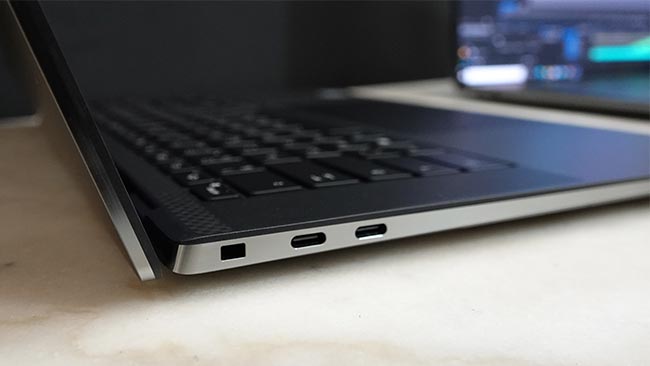
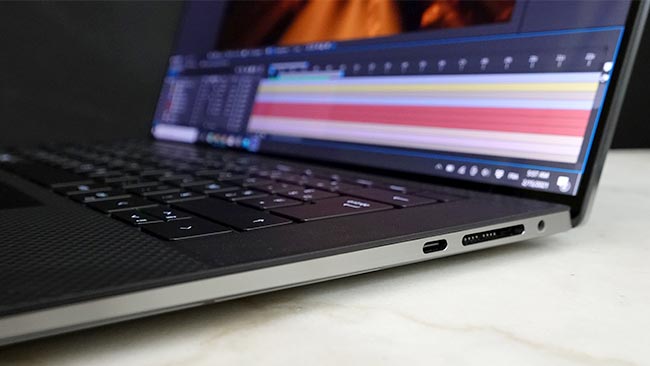
The Precision 5550 provides three Thunderbolt compatible ports and an SD card reader for power and connectivity.
And the performance?
I mentioned that the Precision 5550 is quiet. This is true even under heavy workloads. Yes, you hear the fans spin-up. It is especially noticeable on CPU-intensive workloads – that’s normal. But the additional noise level is moderate and not disturbing.
In the GPU-centric Viewperf 13 benchmark, the Precision 5550 consistently outperformed the Precision 5540 in spite of nearly identical configurations.

Fast, compact, and stylish - the Precision 5550 is a completely new design for the 5500 series.
The performance gains applied to application testing, too. In Premiere Pro the Precision 5550 bested the 5540 by 15% to 40%. Only in the corporate video test did the two systems deliver nearly identical results. That project is more CPU-centric and it is likely that the eight-core i9 in the Precision 5540 shows its advantage over the six-core i7 – even though the i7 CPU is newer.
Another factor in the results is the time difference between tests. The Precision 5550 was tested about fifteen months after the 5540. Adobe released performance optimizations specific to GPU rendering during that time.
These rendering results are normalized to the actual video duration. Rendering results below 100% means the rendering was done faster than video clip duration and rendering results above 100% means the rendering time was longer than the video duration.

Application performance is better on the Precision 5550 despite its more compact size.
The Precision 5550 and the Precision 5540 head-to-head
The Precision 5550 has 6% less surface area and is 30% thinner than the Precision 5540. And while it is smaller, the weight is almost identical. The Precision 5550 weighs just 60 grams more.
Many of the specs appear to be nearly identical: Quadro T2000, Core i9 and Xeon CPUs, 4 TB of storage and 64 GB of RAM capacity. Generational changes in technology seem to give the new 5550 an edge despite it’s more compact size.
One of the first is the Precision 5550’s display which bumps the Dell logo to make room for a higher resolution 3840x2400 display compared to the 5540’s 3840x2160 display. Another is a change from one 2 TB SSD drive and one 2 TB HDD drive in the Precision 5540 to using two 2 TB SSD drives to reach a 4TB storage capacity.
The 64 GB of memory also gets a speed boost from 2666 Mhz to 2933 MHz. The CPU generational jump makes a significant difference, too, although the Precision 5550 tested here uses a Core i7 whereas the Precision 5540 from last year used a Core i9.
On the surface, the GPU might seem to be identical, but that is not the case. The Precision 5550 uses a Quadro T2000 Max-Q Design and the Precision 5540 uses a Quadro T2000 (at least it was not branded as Max-Q Design at the time).
Assuming this to be true, the chip is the same, but the management of the chip is not. The Max-Q Design version reduces the GPU clock speeds which lowers the GPU power from 60W to 40W. This helps Dell’s power and thermal design constraints when creating a much more compact mobile workstation.
The Precision 5550 is smaller, denser, and higher performing than the Precision 5540
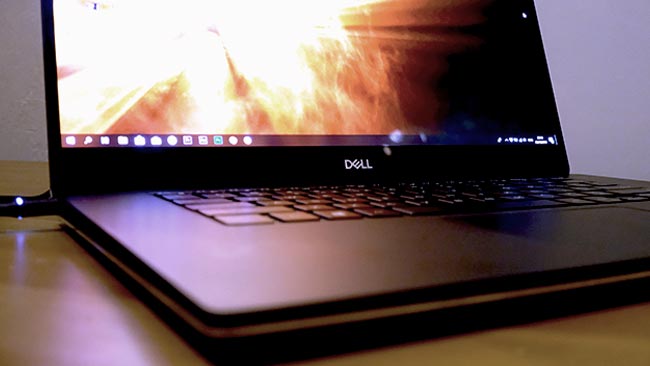
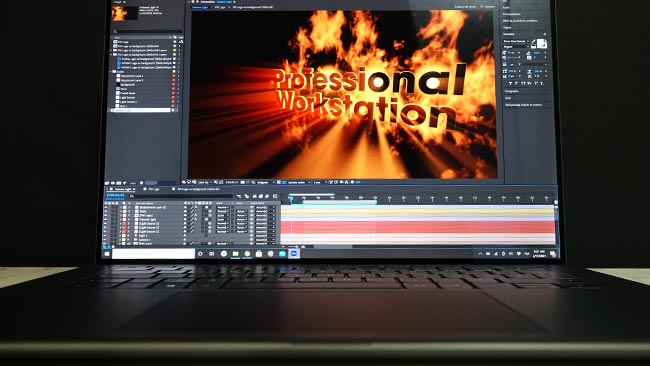
The Dell Logo gets the boot. The Precision 5540's 3840x2160 display (left) is replaced with a 3860x2400 display (right) on the Precision 5550.
If you look only at the specifications, the Quadro T2000 Max-Q Design should be slower, but it outperforms the Quadro T2000 in the Precision 5540 in most tests. Even in the GPU-intensive Viewperf tests, the 5550 consistently outperforms the 5540.
In the Viewperf 13 CATIA tests, the performance edge can be seen in the GPU workload. On the Precision 5550, the GPU consistently runs at a 3% to 5% higher GPU load.
In the Showcase and Solidworks tests, both GPUs are pushed to 100% GPU loads and the CPU turns at 3% to 4%. Despite lower clock speeds on the Quadro T2000 Max-Q Design, the Precision 5550 is visibly faster than the Precision 5540.
There are different possible reasons for the faster GPU performance in the Precision 5550. One: next generation memory and CPU. Two: newer drivers. Three: Max-Q optimizations.
It is unlikely to be the processor or the memory. Viewperf 13 isolates graphics performance and the CPU load typically runs under 15% of the total, although I leave open the possibility that the newer CPU architecture and faster memory might feed the GPU faster thereby increasing the final workload on the Quadro.
The performance advantage could be a difference in drivers since the tests were run about one year apart. It is possible that the better performance is related to optimizations done as part of the “Max-Q Design”.
Regardless of the reason, the result is important. The Precision 5550 is smaller, denser, and higher performing than the Precision 5540.
Usability: Dell keeps you connected
The Precision 5550 reduces the number of built-in ports. It provides three Thunderbolt ports and an SD card reader. To keep you productive and connected, Dell provides a slick Thunderbolt to USB and HDMI connector.
In addition, the dedicated power connector is gone. The 5550 uses the Thunderbolt ports for power. This combination of using Thunderbolt and a nifty dongle shrinks the workstation’s size while assuring that you can be productive right out of the box.
Dell provides a small an handy USB and HDMI adapter. The Thunderbolt cable wraps around the dongle for storage.
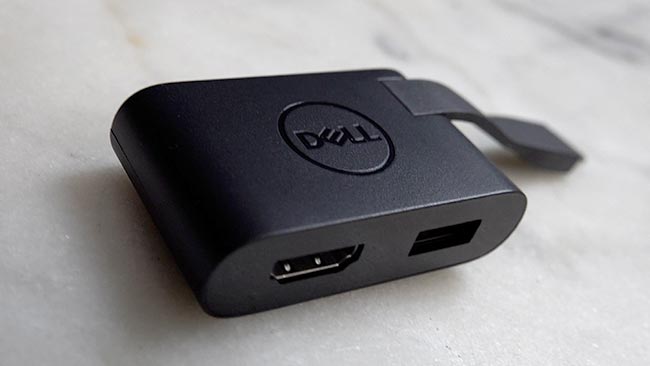
A Final Perspective
What is so great about the Precision 5550? It has a stylish design. It is extremely compact. It has great capacity. And it gets the job done.
The high-end configuration for the Precision 5550 is so impressive for a mobile workstation of this size, that it is essentially impossible to find a weak spot. And if you need a boost in graphics performance without going to a full-blown desktop replacement, then the new Precision 5750 will give you a Quadro RTX 3000 and a 17-inch display in a package that is only slightly larger than the 5550.






